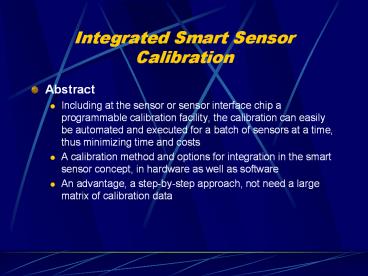Integrated Smart Sensor Calibration - PowerPoint PPT Presentation
1 / 5
Title:
Integrated Smart Sensor Calibration
Description:
... calibration circuit, a limited accuracy bu large bandwidth and high processing speed ... Most methods rely on collecting a complete set of measrement data ... – PowerPoint PPT presentation
Number of Views:88
Avg rating:3.0/5.0
Title: Integrated Smart Sensor Calibration
1
Integrated Smart Sensor Calibration
- Abstract
- Including at the sensor or sensor interface chip
a programmable calibration facility, the
calibration can easily be automated and executed
for a batch of sensors at a time, thus minimizing
time and costs - A calibration method and options for integration
in the smart sensor concept, in hardware as well
as software - An advantage, a step-by-step approach, not need a
large matrix of calibration data
2
- Introduction
- Integrated Smart Sensors (4 integrated functions)
- Analog sensor readout and signal conditioning
- A/D conversion, to provide a digital output
signal - A bus interface, to simplify communication to
microcontrollers, PCs and other devices - Calibration of the sensor tranfer curve,
preferably a digitally programmable calibration - Calibration of Smart Sensors
- An analog calibration circuit, a limited accuracy
bu large bandwidth and high processing speed - A digital calibration facility implementatioin,
high accuracy but limited processing speed - To reduce costs, it is important to minimize the
number of reference measurements, the
communication and the computation power for each
sensor to be calibrated.
3
- 1-D Polynomial Calibration Method
- Calibration Principle
- Most methods rely on collecting a complete set of
measrement data to calculate a correction formula
or lookup table. - As for this proposed method, each calibration
measurement can be used directly to calculate one
programmable coefficient in a correcion function,
which can then immediately be used to correct the
sensor output. - The next calibration makes use of this corrected
sensor signal. Each succeeding correction is
applied in such a way that the previous
calibrations remain undisturebed. - Translating, rotating, and bending, more
calibrations can be done in the same manner to
further linearize the sensor transfer function. - Simulation showes, for 3 or more calibration
steps a good lineariztion is obtained, when the
first calibration point is at one end of the
sensor operation range, the second point at the
other end of the range, and further points
halfway between two previously selected points. - Eq. 1-4, more mathematical details.
4
- Implementation analog signal processor for
polynomial sensor calibration - Fig.4, the signal flow diagram of a four-step
polynomial correction. The diagram can become a
repetitive chain as the dash-boxed part can be
repeated to increase the order of the polynomial
correction, which can be implemented in a
software routine(microcontroller) or in
hardware(either analog or digital). - Fig.5, the block diagram of the analog signal
processor - Low-cost bipolar process
- All signals represented by differential currents
- Addtion/substraction done by connecting current
signals, multiplication implemented in Gilbert
Multiplier - Current duplicator blocks (IV/VI convertor)
- Multiplying DAC (current-mode, 8bit, cascode
dividers) - Bandwidth in the order of 100KHz to 1MHz
5
- Conlusion
- The proposed method doesnt have the disadvantage
of collecting a matrix of data first and then
inverting it or use an iterative method to obtain
the polynomial correction factors. - Instead, it uses each calibration measurement to
obtain one specific correction factor, at the
first to correct the offset, at the second to
correct gain, at the third to correct 2nd-order
non-linearity, etc. Each calibration results in
an additional correction term which is
constructed in such a way that all previous
calibrations remain undisturbed. - This approach also applies for a 2-D calibration
for sensors that suffer from cross-sensitivity to
another parameter. - The error correction is a repetitive procedure,
which can be implemented in software as a small
subroutine, or in hardware as a cascade, pipeline
or a loop of the same building blocks.































